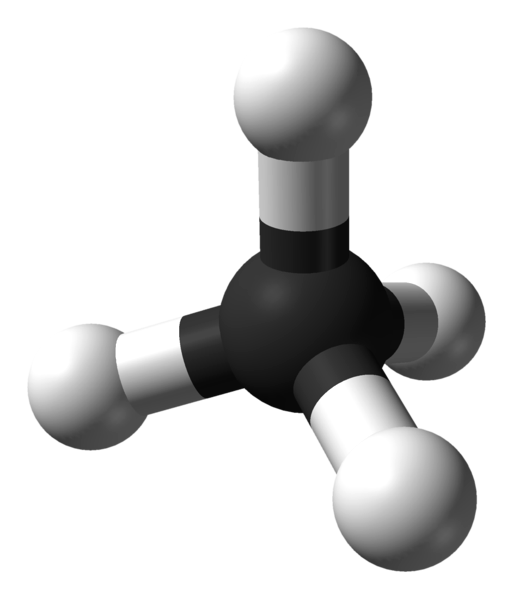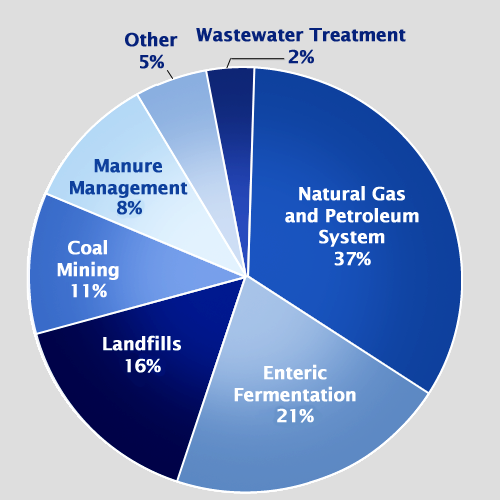Methane as a greenhouse gas - Methane and global warming
Global warming > Methane as a greenhouse gas and global warmingMethane, being a potent greenhouse gas, traps heat and contributes to global warming.
Methane as a greenhouse gas
Methane is an organic compound with the chemical formula CH4.
At room temperature it is a colorless and odorless gas and is the main
component of natural gas. It has four equivalent C-H bonds and is a
tetrahedral molecule.
There are a number of natural and human-influenced (anthropogenic)
sources of emissions of this greenhouse gas. Global emission from
natural sources leading to greenhouse effect is around 250 million
tonnes each year. Emissions from anthropogenic sources is about 320
million tonnes.
This greenhouse gas gets carried to the stratosphere and troposphere by
earth's warming in the tropics and also by upper cyclonic circulations.
There is a natural regulation and check (sink) of this greenhouse
warming gas. Tropospheric methane reacts with hydroxyl radicals formed
from single oxygen atoms and also with water vapour. The end products
are carbon dioxide and water. Some micro organisms (methanotrophs)
present in soils use it as a source of carbon and degrade it. The life
of methane in the atmosphere is about 9-15 years. Over a period of 100
years, it is twenty times more effective than carbon dioxide in
trapping heat and causing global warming.
It has a role in ozone depletion. L. Da Silva et al in their studies on
'Influence of the stratospheric humidity and methane on the ozone
column depletion over the western side of South America', concluded
that humidity and methane transported by vertical winds toward the
stratosphere have a role in the ozone depletion.
Natural and anthropogenic sources of methane
- Natural sources contributing to greenhouse effect and global warming are
wetlands,
termites, oceans and estuaries, permafrost, wildfires,
hydrates in ocean floors, methanogenisis in sediments, mud volcanoes and
wild animals.
Human-influenced (anthropogenic) activities contribute to more than 60% of global emissions and are given below.
All activities connected with petroleum and natural gas like prospecting, production, transport, refining, storage and utilization involves this greenhouse gas contributing warming of earth.
Enteric fermentation in ruminant livestock contributes to greenhouse effect and global warming.
landfills,
coal mining,
agricultural activities like rice cultivation,
manure management,
wastewater treatment,
combustion in mobile and stationery engines and
many industrial processes contribute to the emission of this greenhouse gas and increase global warming.

Ball and stick model image of methane gas molecule

Image Global warming - Greenhouse methane emission sources (http://www.epa.gov)
Possible effects of global warming
An increase in global temperature due methane and other greenhouse gases may have devastating effects. There will be greater melt down of ice and the glaciers will retreat further, permafrost and sea ice will start melting. Methane hydrate deposits in the sea-bed will start releasing the gas adding further to global warming. This will lead to rise in sea levels, inundating many coastal regions. The pattern of precipitation and rain will change and subtropical deserts may expand. Extremes of weather will prevail, with droughts, heat waves and heavy rainfall leading to further global warming. These extremes will result in steep decline in food production and disappearance of fauna and flora.
Global warming increases methane emissions
With the increase in atmospheric levels of methane greenhouse gas there will be further trapping of heat. Global warming will be feeding back methane emissions. With greater flooding of land area, the decay of organic matters will rise with greater production of methane. Methane clathrate (methane hydrate) abounds the ocean floors and continental shelf. Methane hydrate is large amount of methane trapped within crystal structure of water. With global warming these hydrates will lose stability and release large quantities of methane gas.
Reducing anthropogenic methane emissions
Of the total emissions, 60% is due to human-related activities. Changing our ways ofuse of resources of this dynamic nature will go a long way
in reducing greenhouse effect and the global warming. Some suggestions
on cutting down the emissions are given below. References:
1.Inventory of U.S. Greenhouse Gas Emissions and Sinks: 1990-2010 Labels: dynamic nature, global, warming, methane, gas, greenhouse
All-out efforts must be made to stop leakage of methane from natural gas
and petroleum systems. A systematic regulation in industry to stop
leakages as well to collect and use it as an energy source.
Methods to reduce soaking of landfills to be found, as flooded landfills
will encourage methanogenesis (the formation of methane by microbes
known as methanogens) and anaerobic production of this greenhouse gas by
other bacteria. Planting trees in the landfills, encouraging less trash
production, covering landfills and prevention of rain water accumulation
may help in cutting down its formation.
Livestock digest the cellulose in the grass by enteric fermentation with
the help of bacteria present in the intestines. By better feed and
grazing management, enteric fermentation by ruminant livestock can be
brought down and the emission of this greenhouse gas and global warming
can be greatly reduced.
As flooded rice fields are also anthropogenic methane emissions sources,
we can reduce global warming by resorting to finding new rice varieties
suitable for dry rice cultivation and by draining the paddy fields often
to improve aerobic oxidation of the organic matters present and prevent
greenhouse effect.
Following these guidelines may help
us in reducing the emissions of this greenhouse gas and protecting
ourselves from the greenhouse effects and global warming.
2.L. Da Silva, L. Morales and R. R. Cordero, Influence of the stratospheric humidity and methane on the ozone
column depletion over the western side of South America, DOI 10.1393/ncb/i2009-10774-x.
3.http://www.jpl.nasa.gov/education/pdfs/podest_GHG.pdf
Google+ page
By Mahmood Syed Faheem
Advertisement
Disclaimer: Not professional advice - The above content is just for informational & educational purpose only If you need specific medical advice please seek a professional doctor who is licensed or knowledgeable in that area.